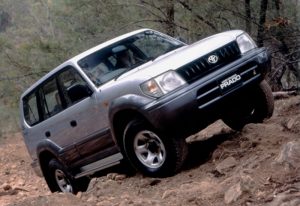Recalls: Toyota 90-Series Landcruiser Prado
Overview
Manufacturers, or importers, issue recalls for defects or faults which have the potential to cause injury. Generally, manufacturers will inform the original buyers if their vehicle is subject to a recall and of the steps required to remedy the defect or fault. Please note that the recalls below (if any) are for Australian-delivered vehicles only. Furthermore, the number of recalls should not be taken as an indication of a model’s reliability or its safety more generally.
Recalls: Toyota 90-Series Landcruiser Prado
Landcruiser Prado V6: fuel tank solenoid valve
In December 1997, a recall was issued for Toyota 90-Series Landcruiser Prado models with V6 petrol engines. In these vehicles, damage to the fuel tank solenoid valve could result in tubes breaking, allowing fuel to leak and causing a fire hazard (PRA 1997/3426).
Landcruiser Prado: front lower ball joints
In May 2005, a recall was issued for Toyota Landcruiser Prado vehicles due to the front suspension lower ball joint potentially having been scratched. If the vehicle were operated for an extended period in this condition, excessive wear of the ball joint may result in looseness of the front suspension. As a result, the driver may also require increased steering effort and experience reduced steering self centring. At worst, the lower ball joint may separate from the knuckle, causing a loss of vehicle steering control (PRA 2005/7749). The recalled vehicles were as follows:
- Model code RZJ95 – VDS: BM99J#; VIS: 00047327-00060247.
- Model code VZJ95 – VDS: BN95J# & BN99J#; VIS: 00086146-00103446.
- Model code KZJ95 – VDS: BY99J#; VIS: 00165768-00173429.
1996-99 LandCruiser Prado: rear axle shaft flange crack
In May 2006, a recall was issued for LandCruiser Prado vehicles that were manufactured from 17 April 1996 to 6 January 1999. In these vehicles, a crack may develop at the neck of the rear axle shaft flange if the vehicle was operated in certain driving conditions, such as repeated high speed driving on winding mountain roads. If the vehicle continued to be operated in this condition, the crack could expand and, at worst, the flange could fracture and cause the wheel to separate from the axle (PRA 2006/8499).
Problems and faults: Toyota 90 Landcruiser Prado
Overview
This section identifies potential problems, causes and fixes based on the experiences of owners and repairers, online sources and technical service bulletins. This information is provided solely for reference purposes and AustralianCar.Reviews recommends that only properly qualified persons carry out repairs or modifications. Furthermore, the number of items below should not be taken as an indicator of a model’s reliability or the frequency with which they may occur.
To report a problem or fault to the AustralianCar.Reviews team, please use the Contact Us form. Note that AustralianCar.Reviews does not offer advice on automotive problems or disputes; such enquiries will not receive a reply. For vehicles purchased from dealers after 1 January 2011, please see our Australian Consumer Law fact sheet.
1KZ-TE overheating
Overheating of the 1KZ-TE engine requires urgent attention since it can cause the cylinder head to crack. Overheating may be caused by:
- Failure of the viscous fan hub – this is generally noticed by temperatures rising when ascending hills or during stop/start traffic on hot days;
- Blockage of the radiator;
- Seizure of the wastegate actuator resulting in overboost;
- A hole in the heater hose; and,
- Too much load on the cooling system – a worn torque converter may contribute to this.
To improve the cooling system, common modifications for the LandCruiser Prado upgrading the radiator and fitting larger exhaust systems.
1KZ-TE cracked cylinder head
As a result of overheating, the 1KZ-TE is susceptible to cracked cylinder heads. Symptoms of a cracked cylinder head include:
- Small bubbles in coolant system, pushing coolant into the overflow bottle;
- Consumption and discolouration of coolant;
- Rapid overheating;
- Rough running; and,
- A loss of power.
If the cylinder head has cracked, the turbocharger is susceptible to overheating – this may cause excessive movement of the shaft and allow the blades to hit the housing. It is recommended that the cylinder head be replaced with a genuine Toyota head since there have been reports of casting faults in non-genuine products.
Please note that pressure testing the cylinder head does not always reveal a problem.
Bottom ball joint failure
Notwithstanding the recall that was issued in May 2005 (see above), there have been cases of the bottom ball joints in Toyota 90/95 Series LandCruiser Prado vehicles failing. It is understood that damage to the rubber boot can cause a lack of lubrication and the ingress of foreign matter. Symptoms of worn ball joints include:
- Stiff or heavy steering;
- Vibration in the front suspension; and,
- Shuddering as the wheels are turned.
If the ball joint separated from the steering knuckle, that wheel would experience total suspension failure. The lower ball joints should therefore be inspected for any movement at every service.
CV joints and boots
The front axles have four ‘constant velocity’ or CV joints: two inboard and two outboard. The CV joints are encased by rubber boots that maintain the CV joints’ supply of grease on the inside and protect against dirt and water ingress. Over time, however, the boot may develop cracks or splits which allow foreign material to enter and damage the CV joint. Symptoms of cracked or split CV boots include:
- A greasy or oily substance on the surface below the vehicle or around the front wheels; or,
- Abnormal clicking noises while driving.
While the driveshaft and CV joint normally have to be removed to replace a boot, the Toyota split boot kit can be fitted without removing the driveshaft.
Other problems and faults
- The automatic transmission oil coolers are located in the engine radiator, such that cracks in the oil coolers can result in engine coolant entering the transmission.
- There have been isolated cases of turbo-diesel engines seizing – this may be due to the injector seals leaking fuel oil down the bores or a blocked sump strainer causing lubricant starvation.
- Previous owners may not have used the auxiliary fuel tank such that the switching mechanism may no longer work and the fuel in the auxiliary tank may have spoiled.




